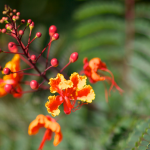Feel like you’re losing the battle against pesky spring weeds every year? Mid-September is the perfect time to apply a preemergent herbicide.
By Juan M. Renteria, Conservation Customer Service Specialist
It’s been a rough summer, but this week we’ll see the kind of temperatures that allow us to get outside and tackle yard projects comfortably.
Among the gardening calendar tasks for the second half of September, this is the opportunity to apply a preemergent herbicide to keep your yard relatively weed-free next spring. While weeds may not be growing much at the moment, Sept. 16 — Dieciséis de Septiembre — is an important time to remember them!
Preemergent herbicides impede the development of cool season weed seedlings — like beggar ticks, bedstraw and sow thistle — that take over our yards every winter and spring. They may seem faraway at the moment, but they had a very rainy spring this year and their prolific seed production will germinate soon as temperatures cool.
A properly applied preemergent herbicide creates a ground-level barrier to limit broadleaf weeds from emerging onto the surface in the first place. Preemergent herbicides are typically applied in a granular form using a rotary spreader, and they’re later activated by rain.
To maximize their effectiveness, there are several factors to consider.
- Know the enemy. Identify your target weeds and know their biology and ecology; eliminating weeds can be difficult due to their different individual life cycles. (Thistles, for example, can have annual, biennial, and perennial durations.)
- Pick the right tools. For broadleaf weeds (dicots), use weed killers like Dimension or Barricade. If your campaigning is targeting grass weeds (monocots) like rescue grass, use a grass product like Amaze. Keep in mind that pre-emergent herbicides do not have a direct effect on the seeds. Because soil microbes degrade herbicide particles, the effect decreases over time and reapplication may be necessary. In south-central Texas, preemergents can be applied after the first rainfall in September (for winter weeds) and again in February to treat summer weeds.
- The battlefield. Be mindful of where preemergent herbicides are applied. They can have an adverse effect on desirable landscapes. Depending on the product used, they can thin the coverage of buffalograss seedlings and/or wildflower seeds. In mulched garden beds, preemergent herbicides may be difficult to apply directly to the soil. In these areas, consider using cardboard or paper under the mulch instead.
- Proceed with caution. Follow the instructions and be sure not to contaminate water by disposing of the product down the drain. (Don’t apply it in areas subject to runoff.)
Remember, preemergent herbicides are not contact herbicides — they won’t affect the summer weeds growing right now in September. For that, you’re better off using a lawnmower or weed eater.
If you prefer a fast-acting contact herbicide, consider wiping out weeds the natural way.
Preemergents provide a strategy for a beautiful lawn that is free of weeds, but first and foremost: before beginning, consider how much desirable grass you really have left. If maintaining an expansive lawn drought after drought becomes a waste of effort and money, it may be a sign it’s time to convert from grass to drought-resilient landscaping instead.
On the bright side, there are many other options, and fall is the perfect time to start new landscape beds! For more ideas on how to declare independence from weeds and grass entirely — and para siempre (forever) — check out GardenStyleSA.com.




